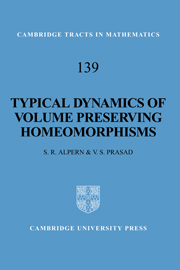Book contents
- Frontmatter
- Contents
- Historical Preface
- General Outline
- Part I Volume Preserving Homeomorphisms of the Cube
- Part II Measure Preserving Homeomorphisms of a Compact Manifold
- Part III Measure Preserving Homeomorphisms of a Noncompact Manifold
- 11 Introduction to Part III
- 12 Ergodic Volume Preserving Homeomorphisms of Rn
- 13 Manifolds Where Ergodicity Is Not Generic
- 14 Noncompact Manifolds and Ends
- 15 Ergodic Homeomorphisms: The Results
- 16 Ergodic Homeomorphisms: Proofs
- 17 Other Properties Typical in M[X, μ]
- Appendix 1 Multiple Rokhlin Towers and Conjugacy Approximation
- Appendix 2 Homeomorphic Measures
- Bibliography
- Index
13 - Manifolds Where Ergodicity Is Not Generic
Published online by Cambridge University Press: 24 August 2009
- Frontmatter
- Contents
- Historical Preface
- General Outline
- Part I Volume Preserving Homeomorphisms of the Cube
- Part II Measure Preserving Homeomorphisms of a Compact Manifold
- Part III Measure Preserving Homeomorphisms of a Noncompact Manifold
- 11 Introduction to Part III
- 12 Ergodic Volume Preserving Homeomorphisms of Rn
- 13 Manifolds Where Ergodicity Is Not Generic
- 14 Noncompact Manifolds and Ends
- 15 Ergodic Homeomorphisms: The Results
- 16 Ergodic Homeomorphisms: Proofs
- 17 Other Properties Typical in M[X, μ]
- Appendix 1 Multiple Rokhlin Towers and Conjugacy Approximation
- Appendix 2 Homeomorphic Measures
- Bibliography
- Index
Summary
Introduction
Up to this point we have shown that ergodicity (as well as other properties) is generic for homeomorphisms of any compact manifold and for Euclidean space Rn. The reader may naturally expect that we will continue in this fashion and show that generic ergodicity holds for any noncompact manifold. The purpose of this chapter is to show that this is not the case by presenting two measured manifolds (X, μ) for which ergodicity is not generic in the space M[X, μ]. After presenting these two examples, we will use them to motivate the notion of an end of a noncompact space. We will give an informal discussion of how the behavior of a homeomorphism h ∈ M[X, μ] with respect to the ends of the manifold X can prevent it, or any homeomorphism close to it (in the compact-open topology), from being ergodic. The two types of behavior found in the counterexamples given in this chapter (namely compressibility and nonzero charge) will have to be excluded, by hypothesis, in the following chapters. In those chapters we will give positive results on the typicality of ergodicity or other dynamical properties in certain closed subspaces of M[X, μ] for general noncompact manifolds X.
Two Examples
In both of the examples of measured manifolds (X, μ) given below, the manifold X is a subset of the plane.
- Type
- Chapter
- Information
- Typical Dynamics of Volume Preserving Homeomorphisms , pp. 98 - 105Publisher: Cambridge University PressPrint publication year: 2001



